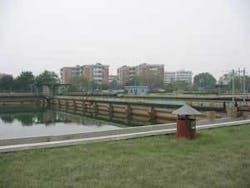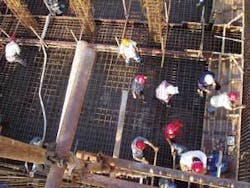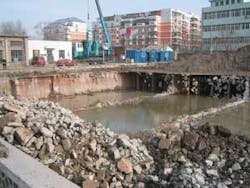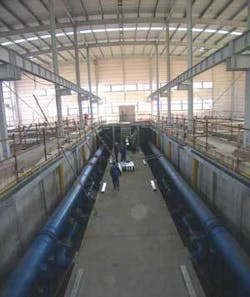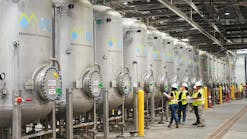The renovated Jie Yuan water treatment plant in China’s largest port city and major industrial center demonstrates one way in which water infrastructure can be upgraded to cost-effectively produce clean drinking water.
New monitoring and analysis systems at the renovated Jie Yuan water treatment plant in Tianjin, China, is expected to enable the facility to comply with potable water standards, which have been raised twice in the past two years by the Ministry of Construction and Health to reverse the nation’s serious water problems.
The refurbished facility is equipped with leading-edge technology that will help reduce chemical use by an estimated 30 percent, prevent the release of harmful gases, and produce clean drinking water.
The Jie Yuan Water Treatment Plant (WTP) in Tianjin, China, supplies potable water to the country’s largest port city and a major industrial center. Located on the “Gold Coast” along the Bohai Gulf in northern China, the 104-year-old facility is one of three water treatment plants serving the city of 10 million people. The facility, which is tucked away in downtown Tianjin, is a model for the urbanized areas of the Republic in many ways.
Economic growth in China’s cities has drawn residents from the countryside into major cities, creating a wave of urbanization. However, new challenges have emerged from this massive development.
The backwash facility of the new plant under construction
Like many waterways throughout China, the Luan and Yellow Rivers, which serve as the source for the treatment plant supply, are contaminated by industrial effluent discharged into the fresh water without proper treatment. This pollution load makes it difficult to treat the water to levels suitable for drinking and other potable uses.
In the summer of 2000, warm temperatures and sunlight combined with the polluted water causing eutrophication to occur, which resulted in a severe algae problem. The century-old Jie Yuan facility was unable to handle the increased strain, so plant operators dumped massive amounts of chemicals in the water to kill the algae. This action solved the algae problem, but the overdose of chemicals could produce unwanted byproducts, such as organic chloride and high concentration of residual iron. Consequently, the water produced at the facility failed to meet even minimum standards and, most noticeably, it did not taste good.
In 2001 the state-run water utility Tianjin Water Company consulted with the US-based consultancy Earth Tech Inc. about the need to renovate and upgrade the existing water treatment facility. The consultancy team proposed that the utility upgrade the facility by installing a customized Dissolved Air Flotation (DAF) process to provide clarification. This solution had never been used in Northern China. The global consulting, construction, and engineering company is based in Long Beach, California.
The DAF technique uses fine air bubbles that attach to solids in the water and float them to the surface of the water, making it easier to remove. This process removes algae and other low-density particles and organisms that contribute to odors and poor tasting water.
To prove the effectiveness of the proposed system, a pilot program of the DAF process and filters was set up just outside of the city in 2001.The results were very positive and, subsequently, a joint venture between Earth Tech and the Tianjin Water Company was formed the following year to design and construct renovations to the Jie Yuan wastewater treatment plant. Today, the facility treats 500 million liters per day, making it one of the largest DAF facilities in the world.
The modernization project was an international effort, with an Earth Tech office in the United Kingdom providing the initial design and a subsidiary of the state-owned utility Tianjin Water Co, the Tianjin Water/Wastewater Design Institute, providing the detailed design. A team managed by both companies oversaw the project.
The old horizontal sedimentation tank
Although the facility had undergone several major renovations in the past, the team was still surprised by the unexpected presence and age of underground pipes that were not marked on the site blueprints. In one instance, for example, the markings on the pipes showed that they were manufactured in England in 1902.
In addition to the age of the facility, the team faced the challenge of building new structures within the crowded footprint of an urban water treatment facility. Surrounded by businesses and residences on every side, there was no room for expansion. The team had to work around existing utilities and carefully manage the flow of incoming cement deliveries and outgoing loads of demolition debris since there was no room to store them at the plant. As a result, the team adopted a two-phased approach that allowed it to demolish some of the infrastructure, such as the reservoirs, backwash pond and a pump station, while keeping the facility fully operational.
Earth Tech also assumed management of the existing facility, which it will operate for 20 years, and about 300 of the plant’s employees. In addition to design and construction work, the project has included advanced operations training for the employees in an on-site center. Some senior plant workers were also sent to Earth Tech facilities in other parts of China and in the United Kingdom and Australia to learn how to safely operate the new technology they would be using.
The refurbished facility will bring the Jie Yuan up to the automation levels seen at water treatment facilities in other parts of China and in western countries. For example, new monitoring and analysis equipment will allow the operations team to optimize the usage of chemicals, which is expected to reduce the quantity needed by about 30 percent.
Pipe gallery
Performance of the new facility is also expected to increase, with online operational data available for operators to review, analyze, and use to diagnose areas for improvement. In addition, breakdowns should be reduced through the use of an alert system that will let operators know when a piece of equipment is in need of maintenance. If a breakdown does occur, the system will provide operators with data records that will allow them to react in a more scientific and expeditious manner than in the past.
The same monitoring equipment will also increase safety at the site by preventing the release of harmful gases, such as chlorine and ammonia, from the facility. The renovated facility entered the testing phase in April 2006 and began full operations in May 2006.
The international cooperation and use of leading-edge technology will help ensure that the Jie Yuan WTP will continue to be a vital lifeline to Tianjin for another 100 years. Perhaps more importantly, the renovated plant should serve as an example to other cities in China, and in neighboring countries, as to how water infrastructure can be upgraded to treat water pollution in a cost-effective and efficient manner.
Authors’ Note
David Chen is the country manager for Earth Tech’s operations in China, has a PhD in hydraulic engineering, and 25 years of experience working on water treatment, environmental science and hydraulic engineering projects throughout Europe and Asia Pacific. Patrick Jiang is the general manager of Tianjin Earth Tech Jie Yuan Water Co., Ltd with seven years of experience working on water treatment projects. Liu Jie is the deputy general manager of Tianjin Earth Tech Jie Yuan Water Co., Ltd, PhD in water treatment with 20 years of experience working on water and wastewater treatment projects throughout Europe and Asia.
Earth Tech wins RoSPA, ICE awards
The prestigious RoSPA Occupational Health and Safety GOLD Award for 2006 was presented to Earth Tech, a Tyco International Ltd. Company on 10 May during the Safety and Health Expo 2006, an exhibition on health and safety-at-work that was held in Birmingham, England. The National Examination Board in Occupational Safety and Health (NEBOSH) sponsored the award.
David Rawlins, the RoSPA awards manager said, “Earth Tech has demonstrated how seriously they take health and safety management and incorporated it as a core part of the company ethos. We would like to see more organizations following their lead by providing a positive approach to health and safety.”
The RoSPA Awards are not just about reducing the number of accidents and cases of ill health at work; they are also about ensuring that organizations have good health and safety management systems in place. These companies help reinforce the message that good health and safety is good business and clearly demonstrate an organization’s commitment to the achievement of high levels of performance in this crucial area.
In addition, the Institute for Civil Engineers (ICE) in the UK presented the top ICE Yorkshire Award to the energy-from-waste project at Sheffield, which was designed by Earth Tech for its client Sheffield Environmental Services. The Energy Recovery Facility enables Sheffield City Council to dispose municipal waste by using it to generate power for the National Grid and supply district heating to municipal buildings including the city hospital, according to the ICE.
